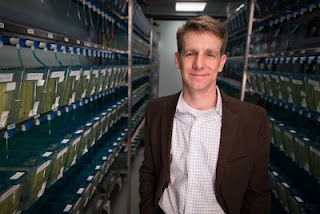Life is full of mysteries ready to be unravelled, full
of questions to be answered, and full of issues ready to be resolved with sheer
will, commitment and consistency, this is what exists in the realm of science
and technology where researchers and powerful scientific minds work hard and
fight fearlessly with the challenges of life in an effort to make the world a
better place for mankind. The very passion to work and make progress has
enabled world to stand a chance against the pandemic currently wreaking havoc
around the globe. But challenges faced by humanity will still exist beyond the
COVID-19 era and to resolve these issues will be of absolute necessity. Many of
the diseases that have been around for centuries will so remain with us (including
cardio vascular, neurological and other) and an imminent solution will be needed
for these challenges.
In order to address these issues a group of
scientist working at the University of
Utah, USA has started their work on development of a new technology which enables
better understanding of genetic basis of such diseases and screening of such
genes resulting in to development of a cure. The researchers have used an approach
that combines aspect of genetic engineering, biotechnology, and material sciences, and is called the
MIC-Drop (Multiplexed Intermixed CRISPR Droplets). The study was lead by Dr. Randall
Peterson who tells that this technology will help in resolving key issues in
genetic screening studies and will ultimately enable genome-sale screening.
 |
| MIC-Drop Courtesy: University of Utah |
THE ISSUE:
Gene editing technology has been used in screening genes but the overall impact for such studies was quite limited as each of the gene would have to be treated separately with each requiring its unique Ribo-Nucliec combination making the whole
 |
| Dr. Randall Peterson, University of Utah |
process exhausting and time consuming. Dr. Randall Peterson said:
“The process has always been focused on a single
gene or a single modification at a time So if you want to do 100 genes, it's
100 times as much work”.
THE SOLUTION:
In order to deal with the issue the Team of Dr.
Randall Peterson came up with an innovative idea of MIC-Drop technology, in
this the team first prepared a large number of gRNA’s and protein molecules followed
by packaging of these components in to micro-droplets and each of the droplet
was given a unique identity inform of a DNA barcode. The chemical properties of
droplets was engineered in order to make them stable and prevent any intermingle
of their particular material contents while delivering in to host cell systems.
The drops are delivered in to separate embryo cells using specific microscopic
needle and the development for each of the cell is monitored later on.
THE SUCCESS
STORY:
In order to demonstrate the potential of this tech
the team worked in collaboration with researchers from Harvard Medical School
and Massachusetts General Hospital, the work was focused on testing about 188 genes
in zebra fish associated with heart development, for the experiment each embryo
cell was loaded with its unique CRISPR containing drop, many of the resulting
fish developed some sort of heart issue and a total of 13 genes were screened out
associated with this issue. Indicating towards many aspect of heart development
which were previously unknown.
Dr. Saba Parvez said:
“Previously, setting up a CRISPR screen of hundreds
of genes in zebra fish would have taken a team of researchers many days and
required hundreds of needles, Now you have streamlined that process into one
user doing it in a span of a couple of hours,”



